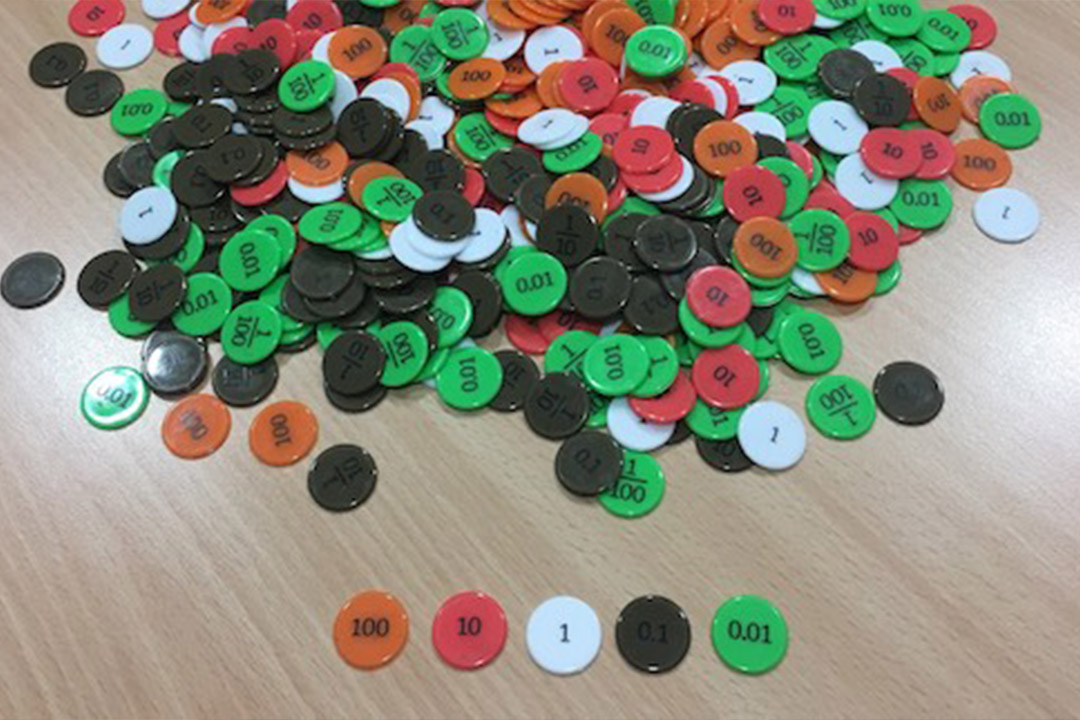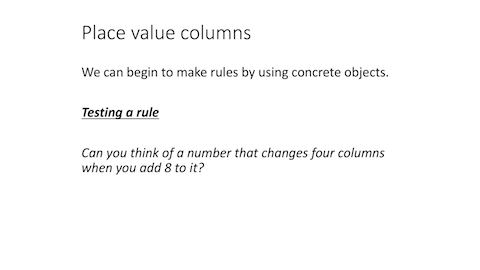Don’t abandon counters just because it’s secondary school
At Trinity Academy in Halifax all teachers are now using place value counters with students across the ability range

At Trinity Academy in Halifax all teachers are now using place value counters – and not only with low attaining students – with students across the ability range. Maths teachers at Trinity Academy, the Lead School for West Yorkshire Maths Hub, have embraced counters following training from primary maths specialists. These specialists were employed by the Maths Hub in addition to the NCETM-trained Primary Mastery Specialists.
One of the principal tenets of teaching for mastery is that all pupils should follow the same curriculum, that all should be given the time to understand a concept deeply. Differentiation is achieved by extra support and intervention for some, and by engaging in maths that encourages understanding the content at greater depth (rather than acceleration onto new content) for others.
However, being faced with the prospect of teaching ‘place value’ to Year 7 can seem rather daunting, or even bizarre.
“Shouldn’t they have done this in primary school?”
“If they haven’t got it by now, how can I change that?”
“They know all this – they will be bored”
The slides that follow show what Trinity Academy teachers have done in Year 7 with place value counters. They have used them to get beyond these worries, and challenge all students’ understanding of place value (and sometimes their own) in the context of addition/subtraction. The counters are not offered as an alternative to standard algorithms, but as a way of understanding what the standard algorithm is really doing. Although the slides shown here are of pictorial representations, the students are encouraged to move real counters around in place-value columns to solve the problems.
With addition:
With subtraction:
Open-ended questions are used to interrogate understanding of what goes on when change in one column produces change in another column:
The slides which follow were developed specifically for those children who it was thought would have already understood place value, as an opportunity to challenge and deepen that understanding. The teacher who developed them, James Greenland, was particularly impressed with how well his top set engaged with them, and by the quality of the conversations.
Please note that there are speaker notes attached to these slides. To view these, click on the Settings icon below and select 'Open speaker notes'.
Trinity Academy’s use of place value counters is just one example of its wider work in encouraging students to engage with multiple representations of mathematical concepts.
In many secondary schools, concrete and pictorial ways of demonstrating a concept have often been left behind, and are sometimes regarded by students as ‘babyish’, or as something to use ‘if you don’t get it’. Teachers can find themselves encouraged to use manipulatives to aid calculations with their low attaining sets, whilst higher attainers are expected to understand with a more abstract approach. However, encouraging students to think about (and connect) a number of different representations of a concept is a powerful way to expose its structure.
‘Proficient problem solvers frequently use representations to solve problems and communicate results. Although representation is a critical part of mathematical work and it is often the first thing that proficient problem solvers do, it is rarely taught in classrooms.’ Jo Boaler (2015)1
Many teachers, including those at Trinity Academy, are now thinking about teaching using different representations with a ‘CPA’ (concrete/pictorial/abstract) approach. Concrete refers to typically using objects that students can handle and physically manipulate, pictorial refers to diagrams, and abstract means either in the head, or using mathematical symbolism. CPA approaches to learning mathematics derive from the work of psychologist Jerome Bruner (1915-2016) – for further reading, see the references at the foot of this article.
At Trinity, the maths department have prioritised their CPA approach as a key focus in their development of teaching for mastery.
‘A mathematical concept or skill has been mastered when, through exploration, clarification, practice and application over time, a person can represent it in multiple ways, has the mathematical language to be able to communicate related ideas, and can think mathematically with the concept so that they can independently apply it to a totally new problem in an unfamiliar situation.’ Helen Drury (2015) 2
Caroline Hamilton, Maths Hub Lead for White Rose Maths Hub, believes that manipulatives and pictures should be offered to all students to aid conceptual understanding, and as a focus to encourage verbalisation of the maths children are doing. However, she emphasises that manipulatives should not become a ‘crutch’ to enable a student to carry out an operation they do not understand, a strategy that is most often used, sometimes unwittingly, with low attaining students.
In order to explore the CPA approach at Trinity Academy, the department has been allocated plenty of time by a supportive management team to pursue teaching for mastery strategies. Resources have been developed, both by the White Rose Maths Hub staff, and by the school’s teachers, and the department has robust lines of communication (both formal and informal) for sharing, developing and discussing these. Caroline says:
“We did a series of sessions (in CPD time), so that every week, we’d drip feed this idea of the concrete, pictorial, abstract, so I think that’s how it became so embedded.”
References
- Boaler, J. 2015. The Elephant in the Classroom. Souvenir Press, London.
- Drury, H. (2014) Mastering Mathematics. Oxford University Press, pp9.
‘Concrete, Pictorial, Abstract’ – further reading:
This case study was first published in 2017.
